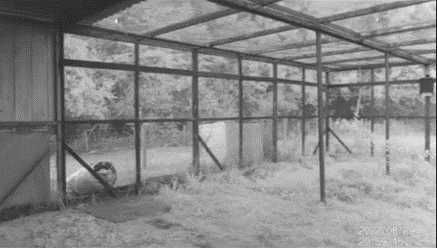Written by Katie Watkins
It has been an another amazing busy year using our bat flight cage that we built in 2020, which is located at Dean Farm Trust. With help from our team of brilliant and dedicated volunteers we have successfully soft released twenty hand reared bats from the cage giving them a second chance in the wild. An enormous team effort - and a great result!

Twelve of these bats were hand reared by volunteers within Severn Wildlife Rescue whilst the others came from Hereford Bat Rescue and other licenced bat carers in South Wales.
Thank you to everyone who helped hand raise this year’s baby bats. As without their dedication to make time in their lives around work, family, sleepless nights, the heart break when a little one doesn’t make it, we would not have had the chance to release as many bats back into the wild as we have this year without you.
We also are grateful to Dean Farm Trust for being so patient with us again this year, whilst we coordinate our bat flight cage.
This year’s bats were all hand reared and had never foraged for food or roosted without mum before in the wild, the soft release process at the flight cage allows them to become accustomed to being a wild bat again and to ensure that the individual has learnt the necessary skills to survive.
During their time in the cage, we are able to monitor them via our cameras to ensure they can pass the three flight tests;
1. Can they take flight from the ground
2. Can they navigate around obstacles and echolocate
3. Can they sustain normal healthy flight for their species
We also deploy a bat detector inside the cage, this detector can be left inside the cage for a whole week and then we take back home to where a bat worker will review the data. From the recorded data we are able to investigate the bat calls which allows us to look for “normal” echolocation for that species including foraging calls.
From this data we are also able to see what species of wild bats are using the nearby woodlands and are flying close to our flight cage. It was fantastic to confirm that there are at least eight species using the area these species include the adorable Brown long eared bat and the rare Barbastelle and Lesser Horseshoe bats. The pictures on the right are sonograms of the calls of Barbastelle and Lesser Horseshoe bats.
In addition to the cameras and the bat detectors, once a week a health check of all the bats is conducted by a licensed bat carer.
This heath check involves checking for any injuries that potentially could be caused from grounding or collision with objects whilst learning to fly and forage. Checking that the individual is regularly grooming and weighing each bat to ensure that they are fit and healthy to return to the wild.

Once we have confirmed that the bats have passed their flight tests and are fit and healthy to return to the wild, they will be moved inside their bat box to inside the soft release hatch. This hatch allows the bats to come and go from the flight cage as they wish. The hatch provides a safe roosting place for the bats, and we still provide supplementary feed for the bats at long as they are roosting there.
Thank you again to everyone's hard work, it has been amazing process to be able to release these bats back to the wild.





Comments